Numerical Investigation of Fluid Flow and In-Cylinder Air Flow Characteristics for Higher Viscosity Fuel Applications
Abstract
:1. Introduction
2. Methodology
2.1. Computer Simulation
2.2. Guide Vane Design (GVD)
2.3. Shallow Depth Re-Entrance Combustion Chamber (SCC)
2.4. Engine Model
3. Simulation Setting
4. Results and Discussion
4.1. Numerical Validations
4.2. Grid Independence Test (GIT)
4.3. Turbulence Kinetic Energy (TKE)
4.4. In-Cylinder Swirl, Tumble and Cross Tumble Ratio
4.5. In-Cylinder Airflow Characteristics during Intake Stroke
4.6. In-Cylinder Airflow Characteristics during Compression Stroke
4.7. In-Cylinder Pressure during Compression Stroke
5. Conclusions
Author Contributions
Funding
Conflicts of Interest
Nomenclature
| English Symbols | Description | Units |
| U | Three dimensional flow velocities x,y and z directions | m/s |
| P | Pressure | Pa |
| T | Temperature | K |
| t | Time | s |
| N | Engine speed | rpm |
| T | Torque | N·m |
| m | Mass | kg |
| L | Litre | l |
| Total enthalpy | J/kg | |
| v | Velocity | m/s |
| vmax | Maximum velocity | m/s |
| Momentum source | N/m3 | |
| Three-dimensional flow | mm/s | |
| R | Radius | mm |
| l | Length | mm |
| x,y,z | Cartesian coordinates | mm |
| Greek Symbols | Description | Units |
| Fluid density | kg/m3 | |
| ω | Angular acceleration | rad/s |
| λ | Thermal conductivity | W/m·K |
| θ | Crank angle degree | - |
| Strain rate | 1/s | |
| Gradient operator | - | |
| Abbreviations | Description | |
| IVO | Intake valve open | |
| IVC | Intake valve close | |
| EVO | Exhaust valve open | |
| EVC | Exhaust valve close | |
| GVD | Guide Vane Design | |
| SCC | Shallow depth re-entrance combustion chamber | |
| IARC | International Agency for Research on Cancer | |
| RPO | Refine Palm Oil | |
| SM | Momentum Source | |
| RT | Tumble Ratio | |
| RS | Swirl Ratio | |
| RCT | Cross Tumble Ratio | |
| TKE | Turbulence Kinetic Energy |
References
- Reitz, R.D.; Duraisamy, G. Review of high efficiency and clean reactivity controlled compression ignition (RCCI) combustion in internal combustion engines. Prog. Energy Combust. Sci. 2015. [Google Scholar] [CrossRef] [Green Version]
- Al-attab, K.; Wahas, A.; Almoqry, N.; Alqubati, S. Biodiesel production from waste cooking oil in Yemen: A techno-economic investigation. Biofuels 2017, 8, 17–27. [Google Scholar] [CrossRef]
- Benbrahim-Tallaa, L.; Baan, R.A.; Grosse, Y.; Lauby-Secretan, B.; El Ghissassi, F.; Bouvard, V.; Guha, N.; Loomis, D.; Straif, K.; International Agency for Research on Cancer Monograph Working Group. Carcinogenicity of diesel-engine and gasoline-engine exhausts and some Nitroarènes. Pollut. Atmos. 2012, 13, 663–664. [Google Scholar] [CrossRef] [Green Version]
- IARC. Diesel and gasoline engine exhausts and some nitroarenes. In IARC Monographs Evaluation Carcinogenic Risks to Humans; IARC: Lyon, France, 2013. [Google Scholar]
- IARC. Diesel and gasoline engine exhausts. In IARC Monographs Evaluation Carcinogenic Risks to Humans; IARC: Lyon, France, 2012. [Google Scholar]
- Rai, R.; Glass, D.C.; Heyworth, J.S.; Saunders, C.; Fritschi, L. Occupational exposures to engine exhausts and other PAHs and breast cancer risk: A population-based case-control study. Am. J. Ind. Med. 2016, 59, 437–444. [Google Scholar] [CrossRef]
- Mauderly, J.L.; Seilkop, S.K. The National Environmental Respiratory Center (NERC) experiment in multi-pollutant air quality health research: II. Comparison of responses to diesel and gasoline engine exhausts, hardwood smoke and simulated downwind coal emissions. Inhal. Toxicol. 2014, 26, 668–690. [Google Scholar] [CrossRef]
- Mat Yasin, M.H.; Mamat, R.; Najafi, G.; Ali, O.M.; Yusop, A.F. Potentials of palm oil as new feedstock oil for a global alternative fuel: A review. Renew. Sustain. Energy Rev. 2017, 79, 1034–1049. [Google Scholar] [CrossRef] [Green Version]
- Agarwal, D.; Agarwal, A.K. Performance and emissions characteristics of Jatropha oil (preheated and blends) in a direct injection compression ignition engine. Appl. Therm. Eng. 2007, 27, 2314–2323. [Google Scholar] [CrossRef]
- Li, J.; Yang, W.M.; An, H.; Maghbouli, A.; Chou, S.K. Effects of piston bowl geometry on combustion and emission characteristics of biodiesel fueled diesel engines. Fuel 2014, 120, 66–73. [Google Scholar] [CrossRef]
- Hamid, M.F.; Idroas, M.Y.; Sa’ad, S.; Bahri, A.J.S.; Sharzali, C.M.; Zainal, Z.A. Numerical investigation of in-cylinder air flow characteristic improvement for Emulsified biofuel (EB) application. Renew. Energy 2018, 127, 84–93. [Google Scholar] [CrossRef]
- Ali, O.M.; Mamat, R.; Abdullah, N.R.; Abdullah, A.A. Analysis of blended fuel properties and engine performance with palm biodiesel-diesel blended fuel. Renew. Energy 2015, 86, 59–67. [Google Scholar] [CrossRef] [Green Version]
- Ren, Y.; Li, X.G. Numerical study on the combustion and emission characteristics in a direct-injection diesel engine with preheated biodiesel fuel. J. Automob. Eng. 2011, 225, 531–543. [Google Scholar] [CrossRef]
- Cheng, C.H.; Cheung, C.S.; Chan, T.L.; Lee, S.C.; Yao, C.D.; Tsang, K.S. Comparison of emissions of a direct injection diesel engine operating on biodiesel with emulsified and fumigated methanol. Fuel 2008, 87, 1870–1879. [Google Scholar] [CrossRef]
- Khond, V.W.; Kriplani, V.M. Effect of nanofluid additives on performances and emissions of emulsified diesel and biodiesel fueled stationary CI engine: A comprehensive review. Renew. Sustain. Energy Rev. 2016, 59, 1338–1348. [Google Scholar] [CrossRef]
- Mofijur, M.; Rasul, M.G.; Hyde, J.; Azad, A.K.; Mamat, R.; Bhuiya, M.M.K. Role of biofuel and their binary (diesel-biodiesel) and ternary (ethanol-biodiesel-diesel) blends on internal combustion engines emission reduction. Renew. Sustain. Energy Rev. 2016. [Google Scholar] [CrossRef] [Green Version]
- Agarwal, A.K.; Dhar, A.; Gupta, J.G.; Kim, W., II; Choi, K.; Lee, C.S.; Park, S. Effect of fuel injection pressure and injection timing of Karanja biodiesel blends on fuel spray, engine performance, emissions and combustion characteristics. Energy Convers. Manag. 2015, 91, 302–314. [Google Scholar] [CrossRef]
- Taib, N.M.; Mansor, M.R.A.; Mahmood, W.M.F.W. Modification of a direct injection diesel engine in improving the ignitability and emissions of diesel-ethanol-palm oil methyl ester blends. Energies 2019, 12, 2644. [Google Scholar] [CrossRef] [Green Version]
- Kim, H.Y.; Ge, J.C.; Choi, N.J. Effects of fuel injection pressure on combustion and emission characteristics under low speed conditions in a diesel engine fueled with palm oil biodiesel. Energies 2019, 12, 3264. [Google Scholar] [CrossRef] [Green Version]
- Abed, K.A.; Gad, M.S.; El Morsi, A.K.; Sayed, M.M.; Elyazeed, S.A. Effect of biodiesel fuels on diesel engine emissions. Egypt. J. Pet. 2019, 28, 183–188. [Google Scholar] [CrossRef]
- Bari, S.; Saad, I. Performance and emissions of a Compression Ignition (CI) engine run with biodiesel using guide vanes at varied vane angles. Fuel 2015, 143, 217–228. [Google Scholar] [CrossRef]
- Bari, S.; Saad, I. CFD modelling of the effect of guide vane swirl and tumble device to generate better in-cylinder air flow in a CI engine fuelled by biodiesel. Comput. Fluids 2013, 84, 262–269. [Google Scholar] [CrossRef]
- Bae, C.; Kim, J. Alternative fuels for internal combustion engines. Proc. Combust. Inst. 2017. [Google Scholar] [CrossRef]
- Mallick, M.; Kumar, A.; Tamboli, N.; Kulkarni, A. Study on drag coefficient for the flow past a cylinder. Physics 2014, 5, 301–306. [Google Scholar]
- Hwang, J.; Qi, D.; Jung, Y.; Bae, C. Effect of injection parameters on the combustion and emission characteristics in a common-rail direct injection diesel engine fueled with waste cooking oil biodiesel. Renew. Energy 2014, 63, 9–17. [Google Scholar] [CrossRef]
- Yadav, S.P.R.; Saravanan, C.G. Engine characterization study of hydrocarbon fuel derived through recycling of waste transformer oil. J. Energy Inst. 2015, 88, 386–397. [Google Scholar] [CrossRef]
- Voutchkov, I.; Keane, A.; Shahpar, S.; Bates, R. (Re-) Meshing using interpolative mapping and control point optimization. J. Comput. Des. Eng. 2018, 5, 305–318. [Google Scholar] [CrossRef]
- Blanchard, G.; Loubère, R. High order accurate conservative remapping scheme on polygonal meshes using a posteriori MOOD limiting. Comput. Fluids 2016, 136, 83–103. [Google Scholar] [CrossRef] [Green Version]
- ANSYS Inc. ANSYS Fluent Theory Guide; Release 18.2; ANSYS Inc.: Ganonsburg, PA, USA, 2013. [Google Scholar]
- Rahman, M.M.; Mohammed, M.K.; Bakar, R.A. Effect of air fuel ratio on engine performance of single cylinder port injection hydrogen fueled engine: A numerical study. In Proceedings of the International MultiConference of Engineers and Computer Scientists, Hong Kong, China, 18–20 March 2009. [Google Scholar]
- Rajak, U.; Nashine, P.; Singh, T.S.; Verma, T.N. Numerical investigation of performance, combustion and emission characteristics of various biofuels. Energy Convers. Manag. 2018, 156, 235–252. [Google Scholar] [CrossRef]
- Baumann, M.; di Mare, F.; Janicka, J. On the validation of large eddy simulation applied to internal combustion engine flows part II: Numerical analysis. Flow Turbul. Combust. 2014, 92, 299–317. [Google Scholar] [CrossRef]
- Stock, H.W.; Haase, W. Navier-Stokes airfoil computations with e sup N transition prediction including transitional flow regions. AIAA J. 2012, 38, 2059–2066. [Google Scholar] [CrossRef]
- Payri, F.; Benajes, J.; Margot, X.; Gil, A. CFD modeling of the in-cylinder flow in direct-injection Diesel engines. Comput. Fluids 2004, 33, 995–1021. [Google Scholar] [CrossRef]
- Prasad, B.V.V.S.U.; Sharma, C.S.; Anand, T.N.C.; Ravikrishna, R.V. High swirl-inducing piston bowls in small diesel engines for emission reduction. Appl. Energy 2011, 88, 2355–2367. [Google Scholar] [CrossRef]
- Miles, P.; Choi, D.; Megerle, M.; Ewert, B.R.; Reitz, R.; Lai, M.C.; Sick, V. The influence of swirl ratio on turbulent flow structure in a motored HSDI diesel engine—A combined experimental and numerical study. SAE Tech. Pap. 2010. [Google Scholar] [CrossRef]
- Hamid, M.F.; Idroas, M.Y.; Basha, M.H.; Saad, S.; Mat, S.C.; Khalil, M.; Zainal, Z.A. Numerical study on dissimilar guide vane design with SCC piston for air and emulsified biofuel mixing improvement. Chemistry 2016. [Google Scholar] [CrossRef] [Green Version]
- Kim, K.; Chung, J.; Lee, K.; Lee, K. Investigation of the swirl effect on diffusion flame in a direct-injection (DI) diesel engine using image processing technology. Energy Fuels 2008, 22, 3687–3694. [Google Scholar] [CrossRef]
- Buhl, S.; Gleiss, F.; Kohler, M.; Hartmann, F.; Messig, D.; Brucker, C.; Hasse, C. A combined numerical and experimental study of the 3D tumble structure and piston boundary layer development during the intake stroke of a gasoline engine. Flow Turbul. Combust. 2017, 98, 579–600. [Google Scholar] [CrossRef] [Green Version]
- Khalighi, B. Study of the intake tumble motion by flow visualization and particle tracking velocimetry. Exp. Fluids 1991, 10, 230–236. [Google Scholar] [CrossRef]
- Rabault, J.; Vernet, J.A.; Lindgren, B.; Alfredsson, P.H. A study using PIV of the intake flow in a diesel engine cylinder. Int. J. Heat Fluid Flow 2016. [Google Scholar] [CrossRef] [Green Version]
- Wang, T.; Liu, D.; Tan, B.; Wang, G.; Peng, Z. An investigation into in-cylinder tumble flow characteristics with variable valve lift in a gasoline engine. Flow Turbul. Combust. 2015, 94, 285–304. [Google Scholar] [CrossRef]
- Heywood, J.B. Internal Combustion Engine Fundementals; McGraw-Hill Education: New York, NY, USA, 1998. [Google Scholar]


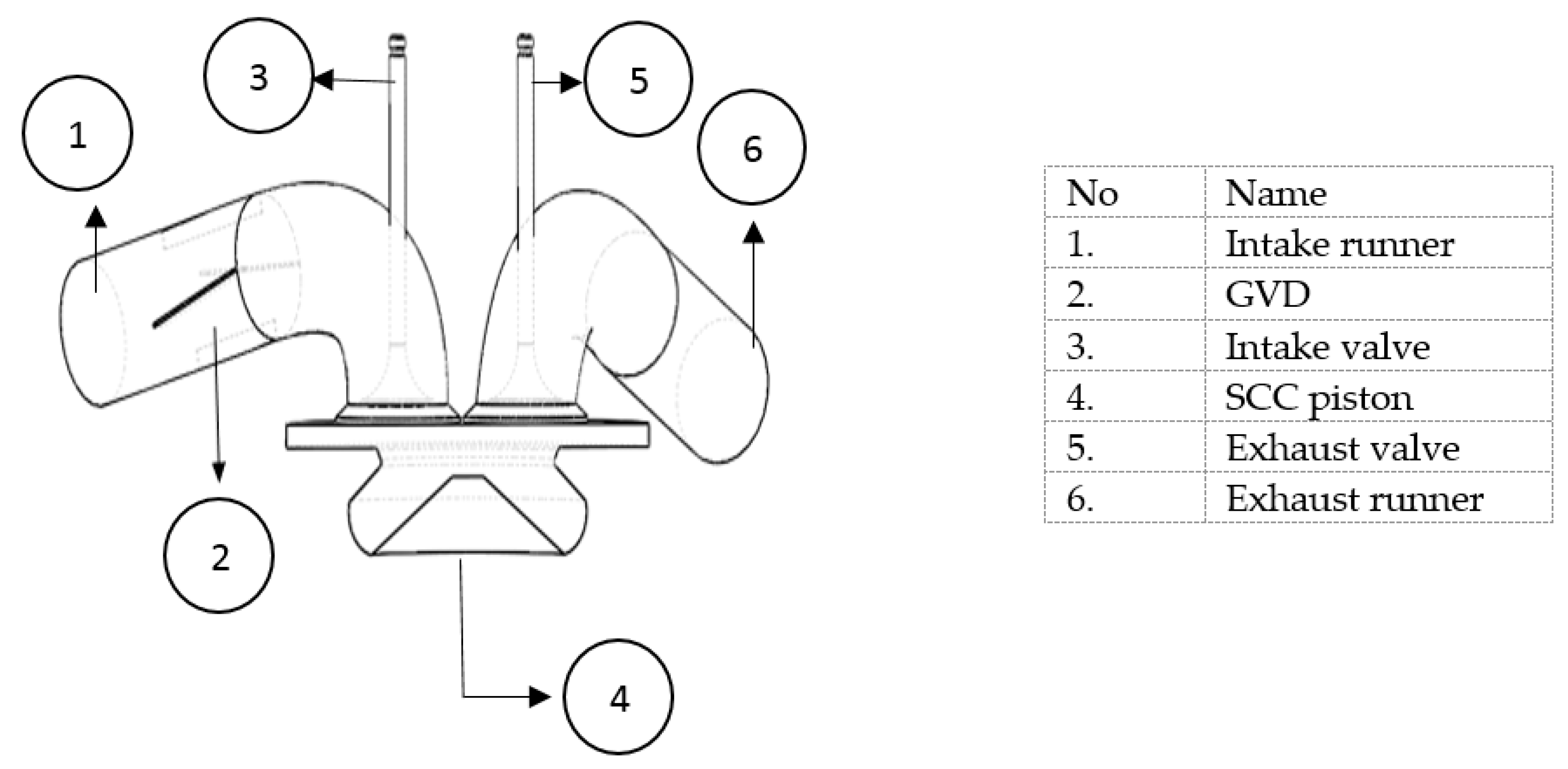
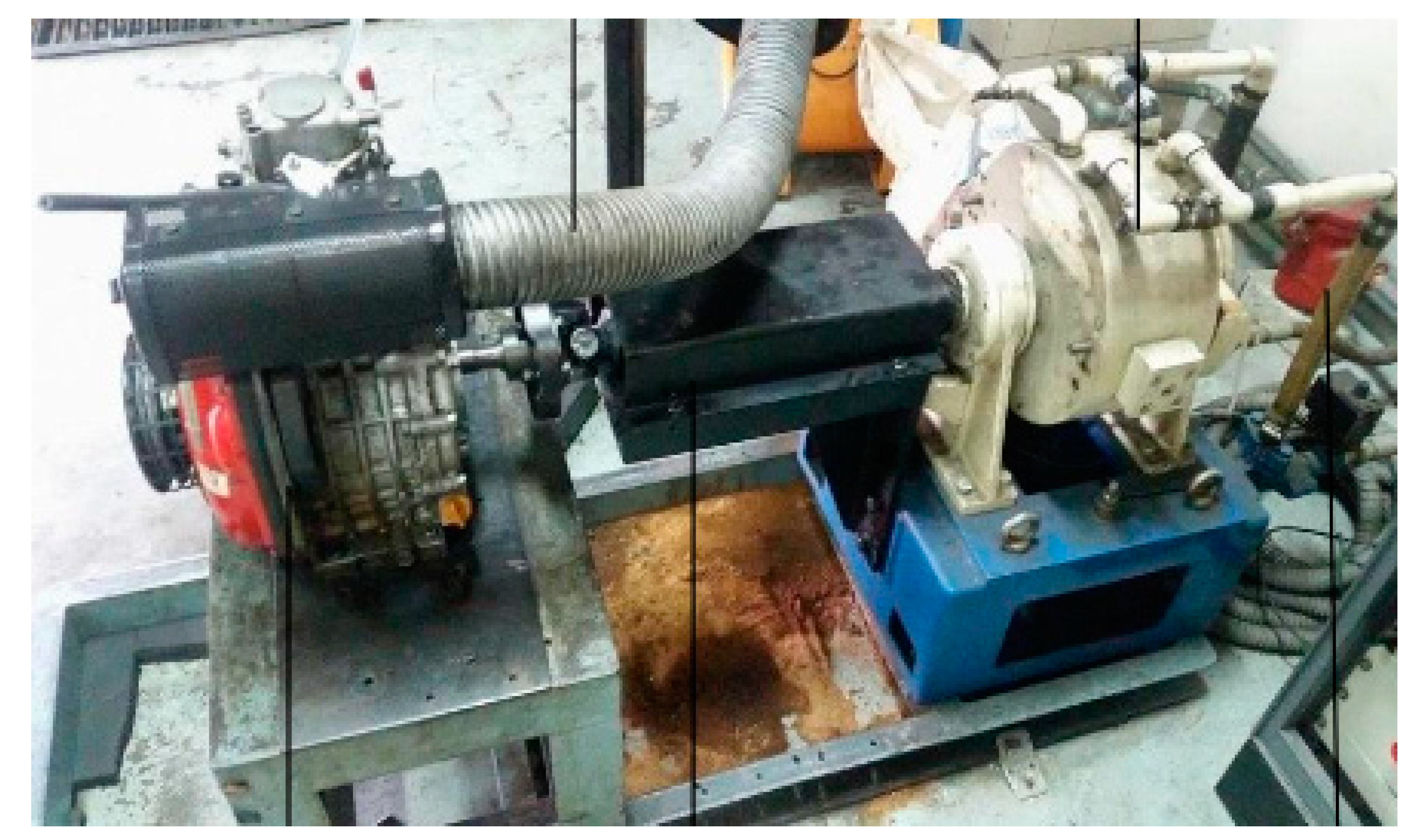
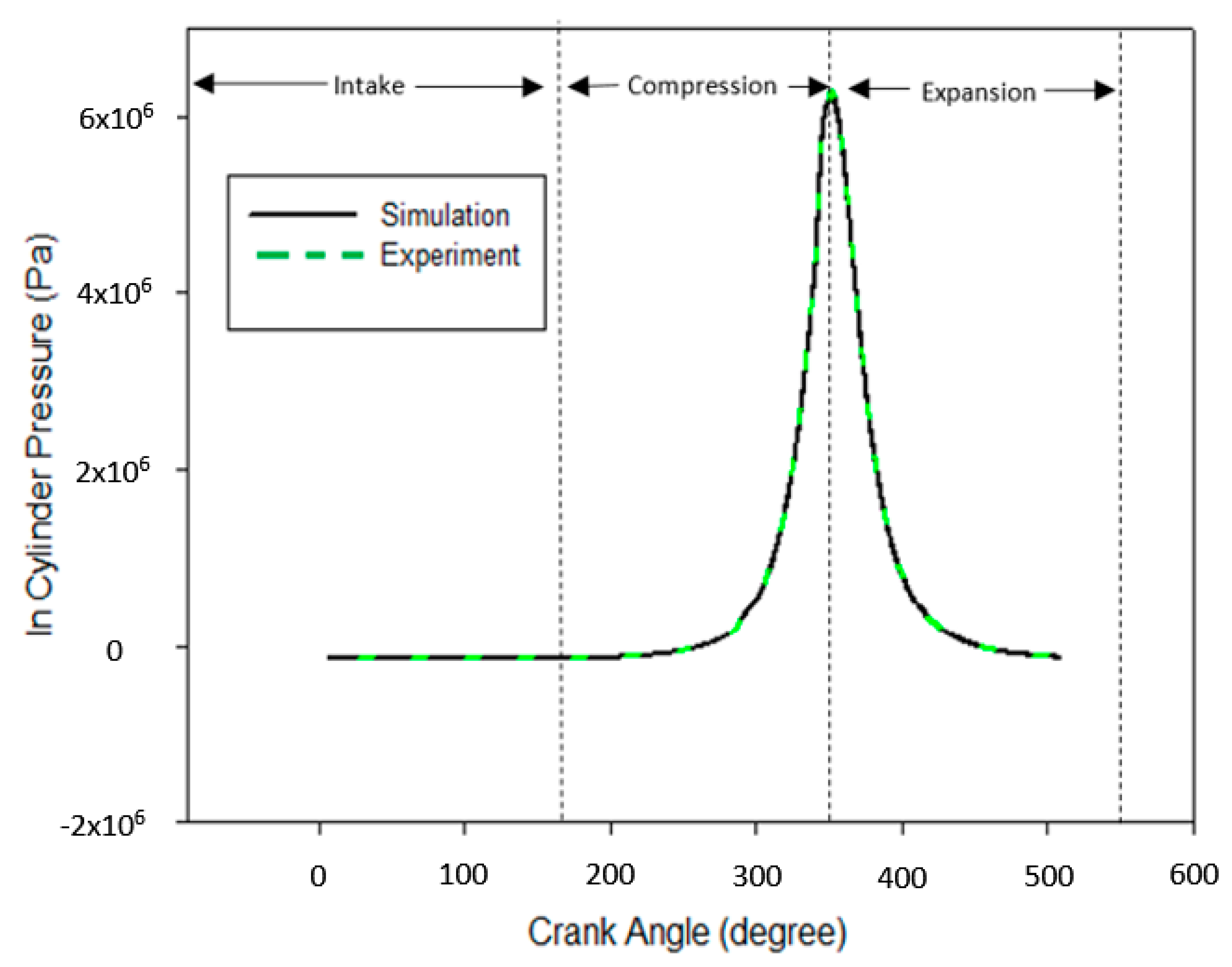


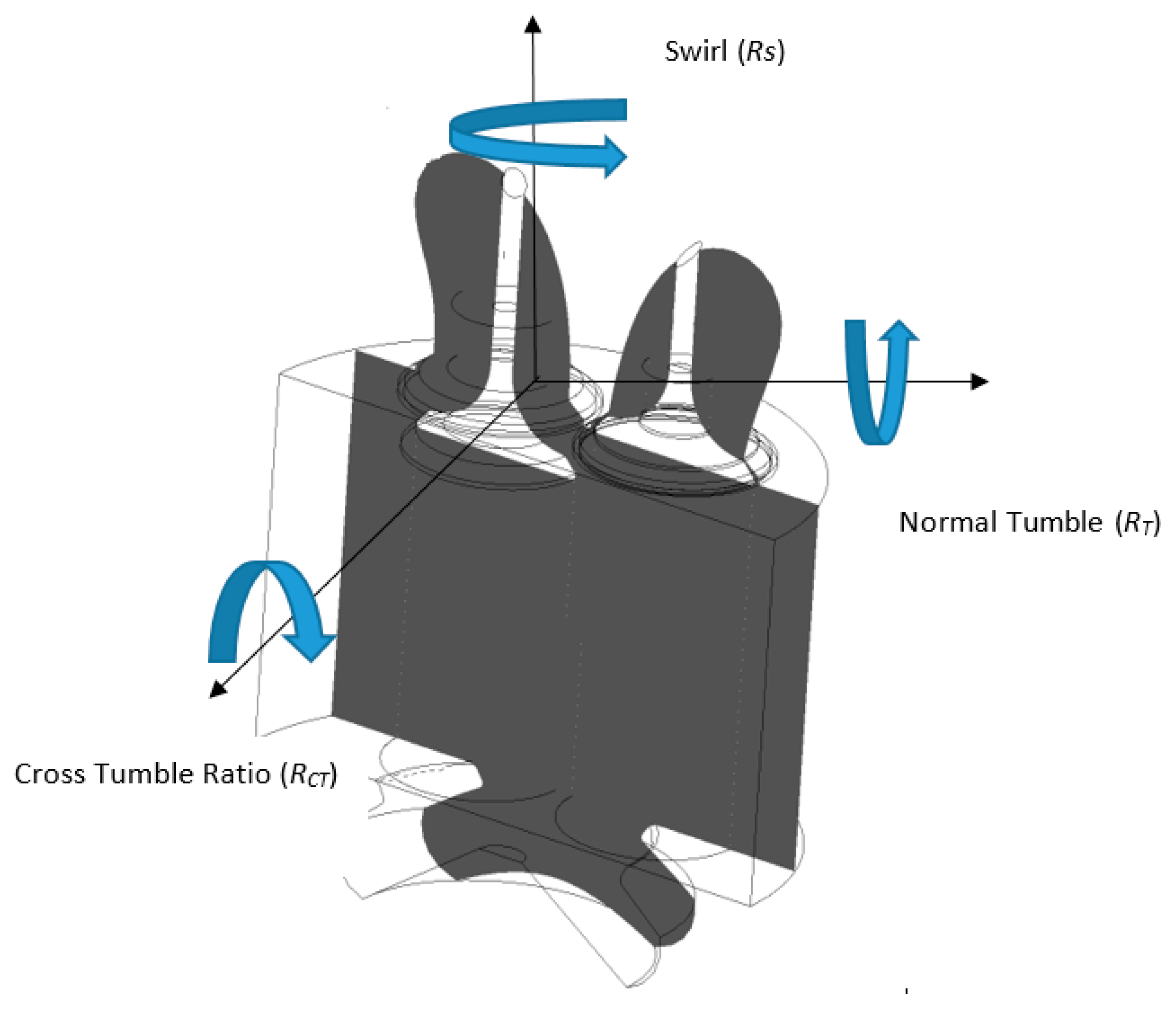
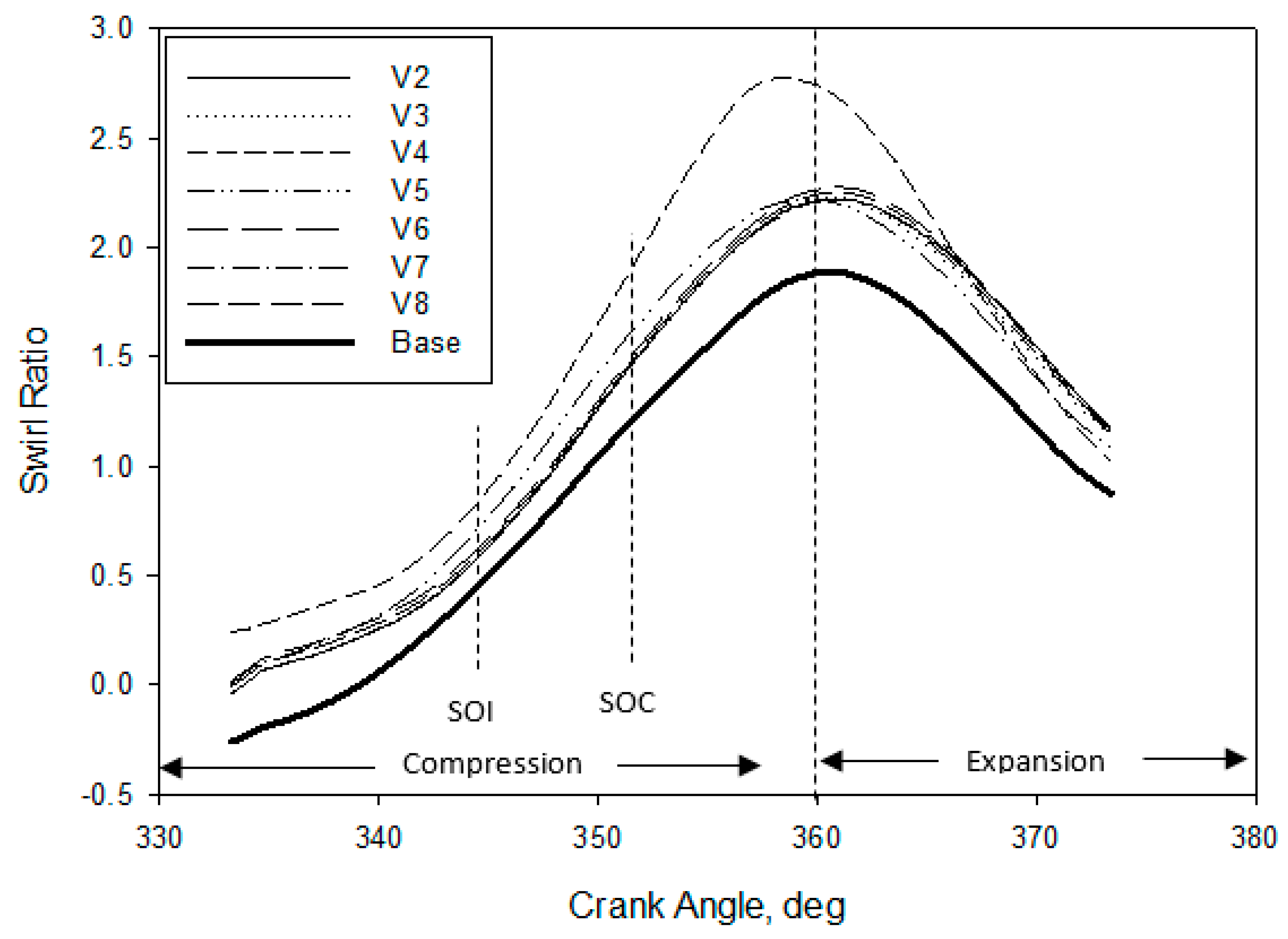


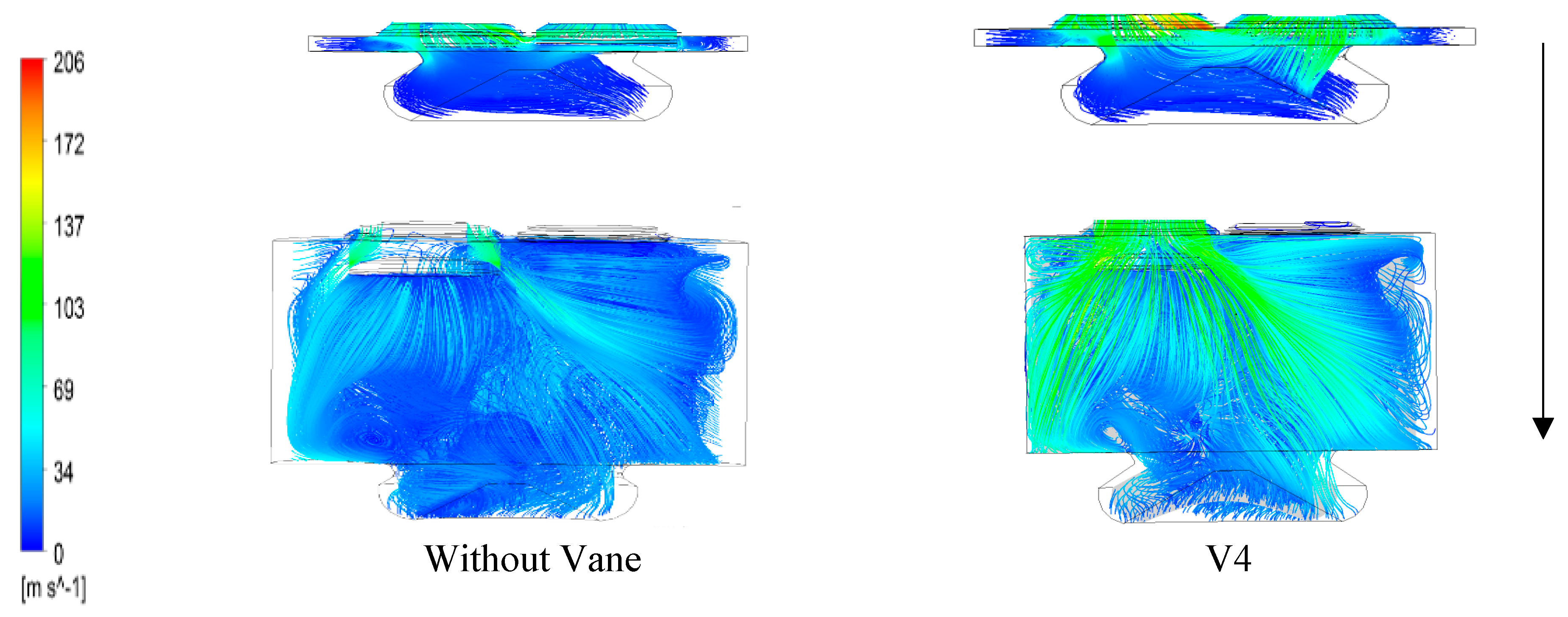


| No | Parameter | Value |
|---|---|---|
| 1 | Number of Vanes (N) | Base, 2,3,4,5,6,7,8 |
| 2 | Vane Length (l) | 30 mm |
| 3 | Width of vane | 0.5 mm |
| 4 | Vane Height (Hv) | 0.6 R |
| 5 | Vane twist angle (θ) | 35° |
| 6 | Angle of incidence | 90° |
| Engine Parameters | Details |
|---|---|
| Engine Model | Yanmar L70AE |
| Bore | 78 mm |
| Stroke | 62 mm |
| Compression ratio | 19.1 |
| Number of cylinder | 1 |
| Engine weight | 36 kg |
| Type of injection | Direct inject |
| Fuel injection pressure | 19.6 Mpa |
| Displacement | 0.296 L |
| High idle speed | 3600 rpm |
| Max. rated power | 4.9 kW @ 3600 rpm |
| Injection timing | 14° ± 1° BTDC |
| Intake | Naturally aspirated |
| Cooling | Forced air |
| Lubrication | Forced lubrication with trochoid pump |
| Direct of rotation | Counter clockwise |
| Starting system | Electric start/Recoil start |
| IVO, IVC | 155°, 59° |
| EVO, EVC | −59°, 155° |
| Case | 1 | 2 | 3 | 4 | 5 |
|---|---|---|---|---|---|
| Elements average cylinder | 102,343 | 254,223 | 302,309 | 371,424 | 447,573 |
| Pressure | 2.082 × 106 | 3.099 × 106 | 3.153 × 106 | 3.153 × 106 | 3.153 × 106 |
© 2020 by the authors. Licensee MDPI, Basel, Switzerland. This article is an open access article distributed under the terms and conditions of the Creative Commons Attribution (CC BY) license (http://creativecommons.org/licenses/by/4.0/).
Share and Cite
Hamid, M.F.; Idroas, M.Y.; Sa’ad, S.; Yew Heng, T.; Che Mat, S.; Zainal Alauddin, Z.A.; Shamsuddin, K.A.; Shuib, R.K.; Abdullah, M.K. Numerical Investigation of Fluid Flow and In-Cylinder Air Flow Characteristics for Higher Viscosity Fuel Applications. Processes 2020, 8, 439. https://doi.org/10.3390/pr8040439
Hamid MF, Idroas MY, Sa’ad S, Yew Heng T, Che Mat S, Zainal Alauddin ZA, Shamsuddin KA, Shuib RK, Abdullah MK. Numerical Investigation of Fluid Flow and In-Cylinder Air Flow Characteristics for Higher Viscosity Fuel Applications. Processes. 2020; 8(4):439. https://doi.org/10.3390/pr8040439
Chicago/Turabian StyleHamid, Mohd Fadzli, Mohamad Yusof Idroas, Shukriwani Sa’ad, Teoh Yew Heng, Sharzali Che Mat, Zainal Alimuddin Zainal Alauddin, Khairul Akmal Shamsuddin, Raa Khimi Shuib, and Muhammad Khalil Abdullah. 2020. "Numerical Investigation of Fluid Flow and In-Cylinder Air Flow Characteristics for Higher Viscosity Fuel Applications" Processes 8, no. 4: 439. https://doi.org/10.3390/pr8040439
APA StyleHamid, M. F., Idroas, M. Y., Sa’ad, S., Yew Heng, T., Che Mat, S., Zainal Alauddin, Z. A., Shamsuddin, K. A., Shuib, R. K., & Abdullah, M. K. (2020). Numerical Investigation of Fluid Flow and In-Cylinder Air Flow Characteristics for Higher Viscosity Fuel Applications. Processes, 8(4), 439. https://doi.org/10.3390/pr8040439








